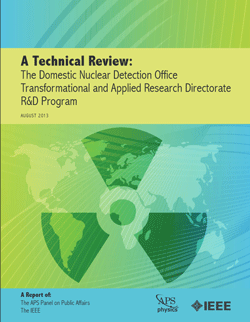A Technical Review: The Domestic Nuclear Detection Office Transformational & Applied Research Directorate R&D Program
Executive Summary
At the request of the Domestic Nuclear Detection Office (DNDO), a Study Committee comprised of representatives from the American Physical Society (APS) Panel on Public Affairs (POPA) and the Institute of Electrical and Electronics Engineers (IEEE) Nuclear and Plasma Sciences Society (NPSS) performed a technical review of the DNDO Transformational and Applied Research Directorate (TARD) research and development program. TARD's principal objective is to address gaps in the Global Nuclear Detection Architecture (GNDA) through improvements in the performance, cost, and operational burden of detectors and systems. The charge to the Study Committee was to investigate the existing TARD research and development plan and portfolio, recommend changes to the existing plan, and recommend possible new R&D areas and opportunities.
The recommendations in this report are meant to help TARD improve their activities and are not an endorsement of the DNDO. The Study Committee believes that DNDO should pursue a future study—carried out by an organization such as the National Academies — of its management approach and that it be undertaken at the earliest possible date, preferably prior to making long-term commitments to additional technology development projects.
The Study Committee has the following general recommendations regarding TARD:
- Create a detailed strategic plan and implementation road map for the development of the GNDA. The plan and road map should be much more specific and quantitative than the current implementation plan, which is highly conceptual and process oriented.
- Create a broad, interactive effort among all of the Directorates of DNDO, the intelligence and user communities, and other government agencies to generate system-wide optimal solution paths for the GNDA. Every component of TARD, from intelligence to operations to detector technology, should be open to review for possible changes in policies and priorities. The review process should particularly inform TARD research and development priorities.
- Develop a clear definition of the end user and the end user needs. The end user needs and constraints must be taken into account at all levels and timescales of the process of developing and carrying out the GNDA and required R&D.
- Conduct a national study to determine the right balance and priorities for security capabilities and R&D for the possible GNDA pathways. The study should include ports, roads, railways, small aircraft, and boats, as well as the use of "surge" capabilities and of standing, networked, and distributed capabilities. We define surge capabilities as the temporary, concentrated deployment of mobile federal, state, and local capabilities in areas where portal-based detection at natural chokepoints is inappropriate (such as within cities and outlying areas). A more comprehensive definition of operations, including associated concepts, should be developed as part of the study. The study should also include the acceptance of risk as a trade-off against unacceptable costs, non-implementable capabilities, and unacceptable courses of action.
- Conduct research into deterrence theory, decision making, uncertainty creation, risk acceptance, the shaping of adversary behavior, and courses of action and adversary responses to US actions, as a means of optimizing GNDA as an overall system.
The Study Committee has reviewed the technical programmatic areas within the TARD R&D portfolio, and makes specific recommendations for each technical area:
- Shielded Nuclear Materials
- Algorithms and Modeling
- Materials
- Nuclear Forensics
- Radiation and Neutron Detection
Within the TARD research programs, the committee notes that past Advanced Technology Demonstrations have lacked adequate analysis, laboratory testing, and quantitative metrics, as well as user input prior to execution of the extensive technology demonstrations. The committee therefore recommends changes to the Advanced Technology Demonstration Program.
TARD experienced significant budget cuts in FY12 disrupting its overall research program. The FY13 budget did restore significant funding enabling TARD to fund a broader range of research projects required for TARD to achieve its overall mission. But the Study Committee notes that ARI funding aimed at university basic research programs has still suffered disproportionate cuts relative to the ATD program; the Committee urges DNDO to carefully examine and evaluate the impact of the budgetary ARI reductions on the prospects for vital long-term transformational discoveries.



